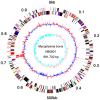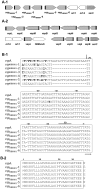Comparative geno-plasticity analysis of Mycoplasma bovis HB0801 (Chinese isolate)
- PMID: 22693604
- PMCID: PMC3365025
- DOI: 10.1371/journal.pone.0038239
Comparative geno-plasticity analysis of Mycoplasma bovis HB0801 (Chinese isolate)
Abstract
Mycoplasma bovis pneumonia in cattle has been epidemic in China since 2008. To investigate M. bovis pathogenesis, we completed genome sequencing of strain HB0801 isolated from a lesioned bovine lung from Hubei, China. The genomic plasticity was determined by comparing HB0801 with M. bovis strain ATCC® 25523™/PG45 from cow mastitis milk, Chinese strain Hubei-1 from lesioned lung tissue, and 16 other Mycoplasmas species. Compared to PG45, the genome size of HB0801 was reduced by 11.7 kb. Furthermore, a large chromosome inversion (580 kb) was confirmed in all Chinese isolates including HB0801, HB1007, a strain from cow mastitis milk, and Hubei-1. In addition, the variable surface lipoproteins (vsp) gene cluster existed in HB0801, but contained less than half of the genes, and had poor identity to that in PG45, but they had conserved structures. Further inter-strain comparisons revealed other mechanisms of gene acquisition and loss in HB0801 that primarily involved insertion sequence (IS) elements, integrative conjugative element, restriction and modification systems, and some lipoproteins and transmembrane proteins. Subsequently, PG45 and HB0801 virulence in cattle was compared. Results indicated that both strains were pathogenic to cattle. The scores of gross pathological assessment for the control group, and the PG45- and HB0801-infected groups were 3, 13 and 9, respectively. Meanwhile the scores of lung lesion for these three groups were 36, 70, and 69, respectively. In addition, immunohistochemistry detection demonstrated that both strains were similarly distributed in lungs and lymph nodes. Although PG45 showed slightly higher virulence in calves than HB0801, there was no statistical difference between the strains (P>0.05). Compared to Hubei-1, a total of 122 SNP loci were disclosed in HB0801. In conclusion, although genomic plasticity was thought to be an evolutionary advantage, it did not apparently affect virulence of M. bovis strains in cattle.
Conflict of interest statement
Figures






Similar articles
-
Genetic characterization of Australian Mycoplasma bovis isolates through whole genome sequencing analysis.Vet Microbiol. 2016 Nov 30;196:118-125. doi: 10.1016/j.vetmic.2016.10.010. Epub 2016 Oct 11. Vet Microbiol. 2016. PMID: 27939147
-
The complete genome sequence of Mycoplasma bovis strain Hubei-1.PLoS One. 2011;6(6):e20999. doi: 10.1371/journal.pone.0020999. Epub 2011 Jun 22. PLoS One. 2011. PMID: 21731639 Free PMC article.
-
Comparative genomic analysis of Canadian Mycoplasma bovis strains isolated from Bison and Cattle.Comp Immunol Microbiol Infect Dis. 2022 Aug;87:101835. doi: 10.1016/j.cimid.2022.101835. Epub 2022 Jun 8. Comp Immunol Microbiol Infect Dis. 2022. PMID: 35751915
-
Proteomics analysis and its role in elucidation of functionally significant proteins in Mycoplasma bovis.Microb Pathog. 2017 Oct;111:50-59. doi: 10.1016/j.micpath.2017.08.024. Epub 2017 Aug 18. Microb Pathog. 2017. PMID: 28826762 Review.
-
Mycoplasma bovis pneumonia in cattle.Anim Health Res Rev. 2007 Dec;8(2):161-86. doi: 10.1017/S1466252307001351. Anim Health Res Rev. 2007. PMID: 18218159 Review.
Cited by
-
Mycoplasma bovis MBOV_RS02825 Encodes a Secretory Nuclease Associated with Cytotoxicity.Int J Mol Sci. 2016 Apr 29;17(5):628. doi: 10.3390/ijms17050628. Int J Mol Sci. 2016. PMID: 27136546 Free PMC article.
-
The effect of multiple evolutionary selections on synonymous codon usage of genes in the Mycoplasma bovis genome.PLoS One. 2014 Oct 28;9(10):e108949. doi: 10.1371/journal.pone.0108949. eCollection 2014. PLoS One. 2014. PMID: 25350396 Free PMC article.
-
Genes found essential in other mycoplasmas are dispensable in Mycoplasma bovis.PLoS One. 2014 Jun 4;9(6):e97100. doi: 10.1371/journal.pone.0097100. eCollection 2014. PLoS One. 2014. PMID: 24897538 Free PMC article.
-
Mycoplasma bovis in Nordic European Countries: Emergence and Dominance of a New Clone.Pathogens. 2020 Oct 23;9(11):875. doi: 10.3390/pathogens9110875. Pathogens. 2020. PMID: 33114269 Free PMC article.
-
Development of a direct competitive ELISA for the detection of Mycoplasma bovis infection based on a monoclonal antibody of P48 protein.BMC Vet Res. 2014 Feb 18;10:42. doi: 10.1186/1746-6148-10-42. BMC Vet Res. 2014. PMID: 24533468 Free PMC article.
References
-
- Caswell JL, Archambault M. Mycoplasma bovis pneumonia in cattle. Animal Health Research Reviews. 2008;8:161–186. - PubMed
-
- Caswell JL, Bateman KG, Cai HY, Castillo-Alcala F. Mycoplasma bovis in respiratory disease of feedlot cattle. Vet Clin North Am Food Anim Pract. 2010;26:365–379. - PubMed
-
- Shi L. Diagnosis of Cattle Infectious Mycoplasma bovis Pneumonia. Journal of Huazhong Agricultural University. 2008;5:629–633.
Publication types
MeSH terms
Substances
LinkOut - more resources
Full Text Sources
Other Literature Sources
Molecular Biology Databases

